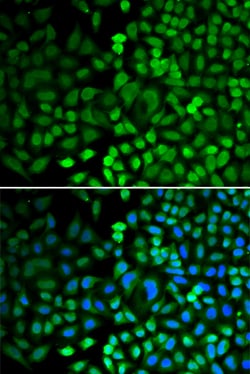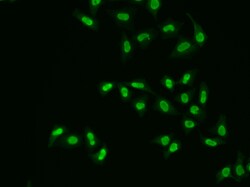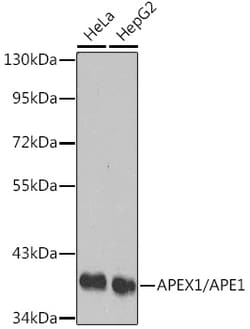Learn More
Invitrogen™ APE1 Polyclonal Antibody


Rabbit Polyclonal Antibody
Supplier: Invitrogen™ PA588088
Description
Immunogen sequence: MPKRGKKGAV AEDGDELRTE PEAKKSKTAA KKNDKEAAGE GPALYEDPPD QKTSPSGKPA TLKICSWNVD GLRAWIKKKG LDWVKEEAPD ILCLQETKCS ENKLPAELQE LPGLSHQYWS APSDKEGYSG VGLLSRQCPL KVSYGIGDEE HDQEGRVIVA EFDSFVLVTA YVPNAGRGLV RLEYRQRWDE AFRKFLKGLA SRKPLVLCGD LNVAHEEIDL RNPKGNKKNA GFTPQERQGF GELLQAVPLA DSFRHLYPNT PYAYTFWTYM MNARSKNVGW RLDYFLLSHS LLPALCDSKI RSKALGSDHC PITLYLAL; Positive Samples: HeLa, HepG2; Cellular Location: Cytoplasm, Endoplasmic reticulum, Mitochondrion, Nucleus, Nucleus speckle, nucleolus.
Mammalian apurinic/apyrimidinic endonuclease (APE/ref-1) is a multifunctional, bipartite enzyme that plays an important role in numerous, cellular functions. APE is responsible for repairing abasic sites in DNA and in regulating the redox state of other proteins that play roles in oxidative signaling, transcription factor regulation (Fos, Jun, NF-kB, Myb, HIF-1 alpha, CREB, Pax), cell cycle control (p53), and apoptosis. The most common form of DNA damage is the creation of abasic sites which are brought about through spontaneous loss or oxidative DNA damage, through chemically initiated hydrolysis (chemotherapy), ionizing radiation, UV irradiation, oxidizing agents, and removal of modified bases by DNA glycosylases. APE is differentially expressed during development and in different tissues. This protein has diverse subcellular localization patterns which support the possibility of its interaction with numerous, other cellular proteins in addition to DNA repair within the nucleus. Regulation of APE by phosphorylation is mediated, at least in part, by casein kinase II. Increases in APE message and protein levels are observed upon the reintroduction of oxygen to hypoxic cells, and in some malignant tissue relative to normal tissue. Decreases in APE expression have been associated with the induction of cellular apoptosis.
Specifications
| APE1 | |
| Polyclonal | |
| Unconjugated | |
| APEX1 | |
| AP endonuclease 1; AP endonuclease class I; AP lyase; Ape; APE1; APEN; Apex; APEX nuclease; APEX nuclease (multifunctional DNA repair enzyme) 1; APEX nuclease 1; Apex1; apurinic/a; Apurinic/apy; apurinic/apyrimidinic (abasic) endonuclease; apurinic/apyrimidinic endodeoxyribonuclease 1; apurinic/apyrimidinic endonuclease; apurinic/apyrimidinic endonuclease 1; Apurinic-apyrimidinic endonuclease 1; APX; BAP 1; BAP1; deoxyribonuclease (apurinic or apyrimidinic); DNA-(apurinic or apyrimidinic site) endonuclease; DNA-(apurinic or apyrimidinic site) lyase; DNA-(apurinic or apyrimidinic site) lyase, mitochondrial; HAP1; protein REF-1; redox factor 1; redox factor-1; REF1; REF-1 | |
| Rabbit | |
| Affinity Chromatography | |
| RUO | |
| 328 | |
| -20°C, Avoid Freeze/Thaw Cycles | |
| Liquid |
| ELISA, Western Blot, Immunocytochemistry | |
| 1.13 mg/mL | |
| PBS with 50% glycerol and 0.02% sodium azide; pH 7.3 | |
| P27695 | |
| APEX1 | |
| Recombinant fusion protein containing a sequence corresponding to amino acids 1-318 of human APEX1/APE1 (NP_5423801). | |
| 100 μL | |
| Primary | |
| Human | |
| Antibody | |
| IgG |
Your input is important to us. Please complete this form to provide feedback related to the content on this product.


